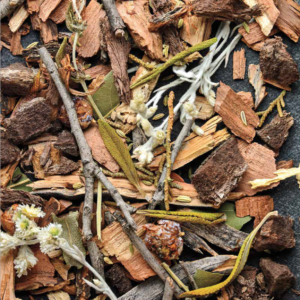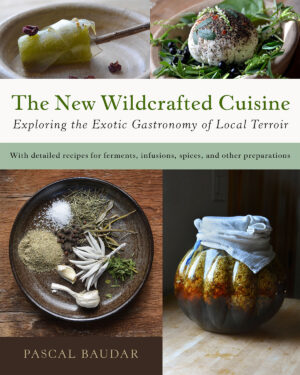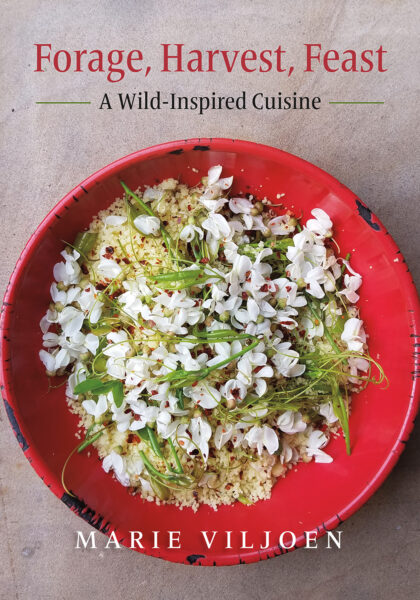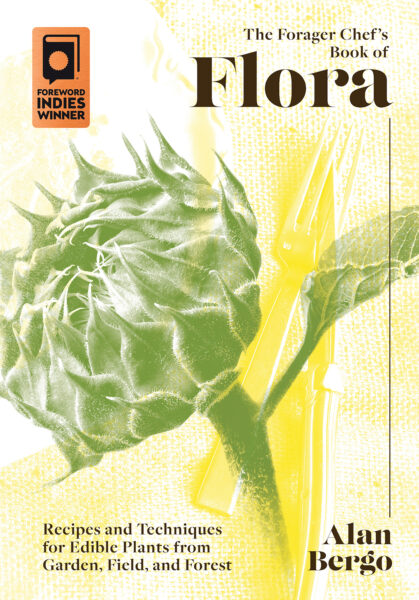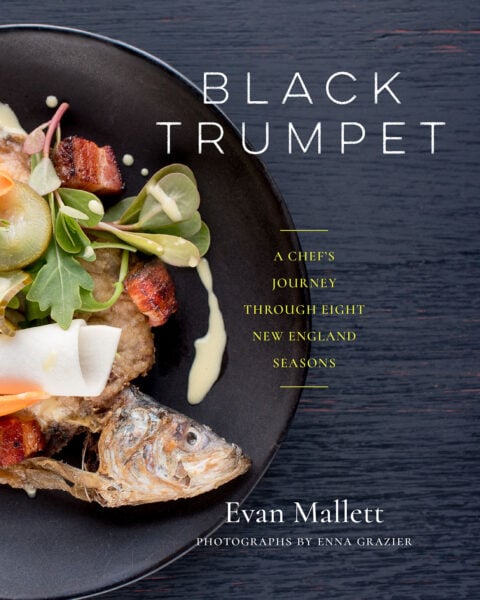Wild Flavors to Fire Up Your Grill: Foraging for Wood and Aromatics
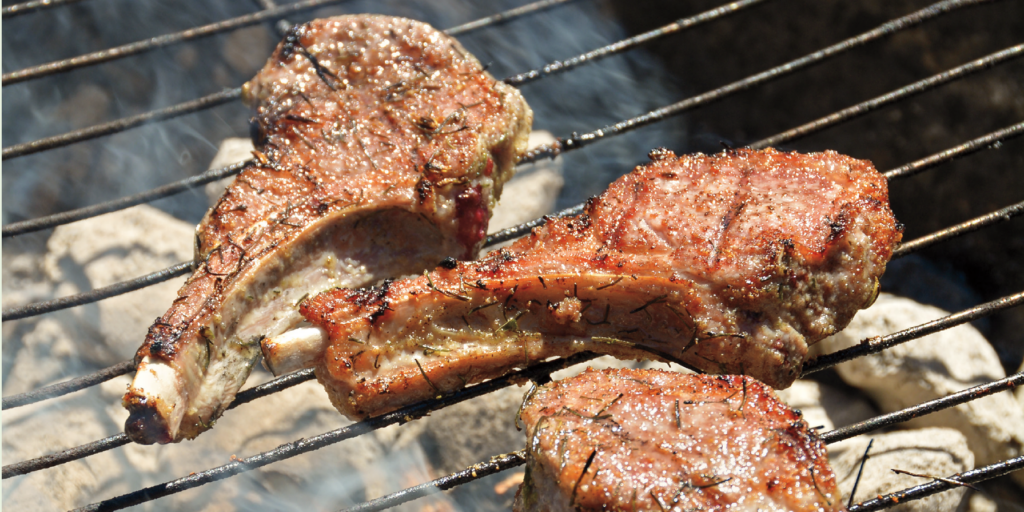
If you love grilling, you probably know that various woods add delicious smoky flavors to grilled meat, fish, and vegetables; but where do you find them? Here are some tips on foraging for wood, bark, and aromatics to help you add a wild twist to anything you toss on the grill this summer.
The following is an excerpt from The New Wildcrafted Cuisine, by Pascal Baudar. It has been adapted for the web.
Foraging for Wood, Bark, and Aromatics
I’ve foraged specific woods and barks that I reduce into chips for local chefs and also for our own cooking, but my favorite application is to create custom “wild ” grilling/smoking blends. When making the blends I’m not stuck with just using various woods and barks—I also like to add some local aromatic ingredients such as California juniper berries or twigs, dehydrated black sage, fennel seeds, and bay leaves.
In addition to the woody and aromatic ingredients, you can add another layer of flavors by infusing the wood chips or barks with beers, wines, or juices. Oak chips infused with elderberry wine add a nice fruity quality to the grill. Manzanita chips infused with mugwort beer impart intense aromatics and a hint of bitterness, a combination that I love with strong-flavored meats such as goat or lamb.
Types of Wood and Aromatics For Your Grill
Woods, barks, aromatics (leaves, plants, and seeds), and the additional infusing step with wild brews have the potential to create so many subtle flavors for grilling and smoking that a whole book could be written on this subject alone.
The locally foraged woods I use for grilling and smoking, along with their taste profiles:
Alder—sweet and musky
Ash—light flavor; good as a base with more
flavorful woodsCalifornia bay—medium flavor, with a hint of bay
Cottonwood—neutral, good to use with more aromatic woods
Eucalyptus—strong flavor; I use it sparingly, since it can be overwhelming
Fig—mild and fruity
Manzanita—mild and fruity
Maple—medium-sweet flavors
Mesquite—strong and somewhat sweet flavors; use sparingly
Oak (wood and bark)—medium; good base for blending with other woods
Olive—medium flavor, with a hint of mesquite
Walnut—medium; a bit bitter
Willow—mild; a bit bitter
The local wild aromatics I use include:
Sages (black sage, white sage, purple sage, etc.) and some sagebrush
Epazote
Eucalyptus leaves
California juniper twigs and berries
Wright’s cudweed
Sweet clover
California bay
Mugwort
Fennel seeds
Using a Grilling/Smoking Blend
I’m not an experienced pit master; I have a simple and cheap charcoal grill, so I tend to keep my cooking quite primitive. However, this procedure works well on gas grills too, and you don’t have to go through lighting the charcoal.
First I prepare the smoking mix. Creating a good mix is a bit of an art form that you need to learn from experience. Some woods, such as mesquite or hickory, may have overwhelming flavors, so it’s best to mix them with other woods. Spices include California juniper twigs and berries, Wright’s cudweed, and fennel seeds.
I like to soak the chips in water for around 30 minutes before use. That way they won’t burn right away on the hot coals. If I plan to soak some of my chips in wine or beers instead of water, I usually do so overnight.
Time to Grill: Making the Fire
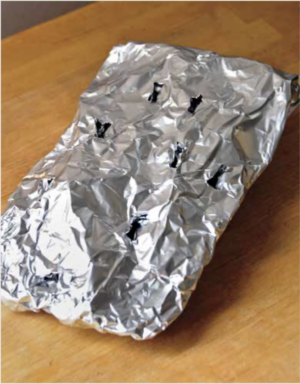 When it comes time for grilling, I make the fire. At the bottom of the grill I place a few pinecones with dry materials, such as leaves, pine needles, and grass. Then I put good layer of store-bought hardwood charcoal over them. Cooking or smoking with pinecones is not a good idea because of their strong and acrid flavors, but by the time the charcoal is going nicely, the pinecones have been reduced to ashes and won’t influence the flavors. I use pinecones at the base because they burn very nicely and are a good starter for the charcoal. Feel free to use other materials.
When it comes time for grilling, I make the fire. At the bottom of the grill I place a few pinecones with dry materials, such as leaves, pine needles, and grass. Then I put good layer of store-bought hardwood charcoal over them. Cooking or smoking with pinecones is not a good idea because of their strong and acrid flavors, but by the time the charcoal is going nicely, the pinecones have been reduced to ashes and won’t influence the flavors. I use pinecones at the base because they burn very nicely and are a good starter for the charcoal. Feel free to use other materials.
Once the fire is going, I usually wait around 20 to 30 minutes for the coals to turn white-hot. When the coals are ready, I either place the smoking mix directly on the white-hot coals or wrap the mix in aluminum foil, poke some holes into the package, and place it over the hot coals. The smoking lasts a bit longer using this method. This is also a great method for cooking on a gas grill.
When to Use Your Foraged Blend
As a rule of thumb I like to throw my blend onto the hot coals around 3 to 5 minutes before I place my food on the grill. If there is too much smoke, I may wait longer. It’s a bit of an art and there are countless opinions about the right way to do it—too much smoke or the wrong blend and the flavors can easily become overpowering.
I like to lightly oil the food I plan to use so it doesn’t stick to the grill. The cooking time will obviously depend on what you are grilling.
When starting to create with your own wild blends, don’t use too much material to begin with and experiment a bit until you get it right and it’s just the way you like it. Remember, it’s all about flavors. If it tastes awesome, your blend was a success.
Choosing the Right Wood
Here are some of the common woods you can forage to use in grilling and smoking. Opinions vary on what constitutes a strong, medium, or mild wood, but this list will give you a good start.
Strong woods:Traditionally, strong-flavored woods such as mesquite, oak, maple, and hickory are mostly used in grilling lamb, beef, and pork. Personally, I consider oak a good medium-flavored base for blending with other highly aromatic woods (such as mesquite and hickory) and for grilling game birds or fish. Medium woods:These woods don’t have overwhelming flavors, like mesquite or hickory, but they still have a lot of character and specific flavor accents. Note that there are no real rules about what wood works best with what meat, fish, or poultry. Experiment and form your own opinion. Acacia (a bit similar to mesquite)—good for meats and vegetables Apple, pear, crab apple, manzanita (sweet and fruity)—good for everything, including curing meats California bay (spicy)—good for meats (I have not tried it with fish or poultry yet) Beech (like oak, a good base)—good for meats, fish, game birds, poultry, and vegetables Birch (slight similarities to maple)—good for meat, fish, and poultry; try it with bacon too Grape (fruity)—good with game birds and strong-flavored meats, such as lamb and goat Juniper—medium strong, so mix with other woods; I love it with seafood Maple (sweet and fruity)—I like this wood with everything; great for curing bacon, ham, and other meats Mulberry—I haven’t experimented with it yet, but it seems to have similarities to manzanita or apple wood Olive—hints of mesquite; a fantastic wood in my opinion, good for everything Walnut—somewhat strong and bitter, use sparingly with other woods; great with game meats |
Mild woods:These woods have mild and often subtle flavors. When creating a blend, any of these woods can provide a good base, and you can add some stronger woods for added flavors. Alder—good for meats, fish, game birds, poultry, and vegetables Almond (a bit sweet)—good for meats, fish, game birds, poultry, and vegetables Avocado—good for meats, fish, game birds, poultry, and vegetables Cherry (fruity and good for blending)—good for meats, fish, game birds, poultry, and vegetables Cottonwood—quite a neutral flavor, in my opinion; use with other woods for flavors Fig (mild and fruity)—I use fig often and for cooking everything; it makes a great base to combine with other woods Lilac (mild, fruity, and spicy)—great with fish, poultry, and vegetables Pecan/chestnut (mild, fruity)—good for meats, fish, game birds, poultry, and vegetables Willow (mild and a tad bitter)—a great base to combine with stronger woods Other woods that can be used:Ash, orange, lemon, grapefruit, apricot, plum, peach, nectarine. Washed seaweed has been traditionally used in Europe for cooking/grilling shellfish. Not to be used:Fir, pine, spruce, cedar, redwood, cypress, elm, sycamore, sweet gum. Although eucalyptus wood is not recommended in the United States, it is used in Australia for its distinctive flavors. I use it very sparingly. Also note that, in France, a traditional dish called éclade features mussels cooked and smoked in pine needles. It’s quite delicious. |
Recommended Reads
Recent Articles
Garlic mustard: while known as “invasive,” this plant can be consumed in its entirety and has great nutritional value. Plus, the garlic-flavor is a perfect addition to any recipe that calls for mustard! The following are excerpts from Beyond the War on Invasive Species by Tao Orion and The Wild Wisdom of Weeds by Katrina…
Read MoreOh, honeysuckle…how we love thee. If only there was a way to capture the sweet essence of this plant so we could enjoy it more than just in passing. Luckily, foraging and some preparation can help make that happen! Here’s a springtime recipe that tastes exactly like honeysuckle smells. The following excerpt is from Forage,…
Read MoreIntroducing…your new favorite brunch dish! This whole broccoli frittata is packed with fresh, wildcrafted flavors that are bound to help you start your day off on the right foot. The following is an excerpt from The Forager Chef’s Book of Flora by Alan Bergo. It has been adapted for the web. RECIPE: Whole Broccoli Frittata…
Read MoreWondering where to forage for greens this spring? Look no further than hedges, which serve as natural havens for wild greens and herbs! The following is an excerpt from Hedgelands by Christopher Hart. It has been adapted for the web. Food from Hedges: Salads and Greens Let’s start by looking at all the wild foods…
Read MoreThere’s a whole new world out there when it comes to koji. It doesn’t matter if you’re making bread, cheese, or ice cream, koji helps you pump up the flavor! Growing Koji in Your Own Kitchen Koji, the microbe behind the delicious, umami flavors of soy sauce, miso, fermented bean sauce, and so many of…
Read More

